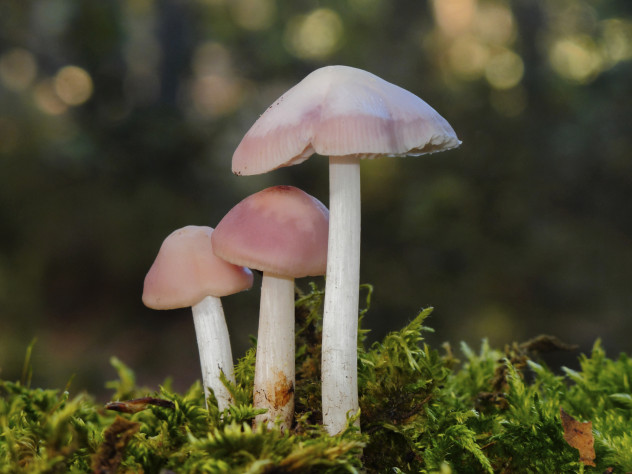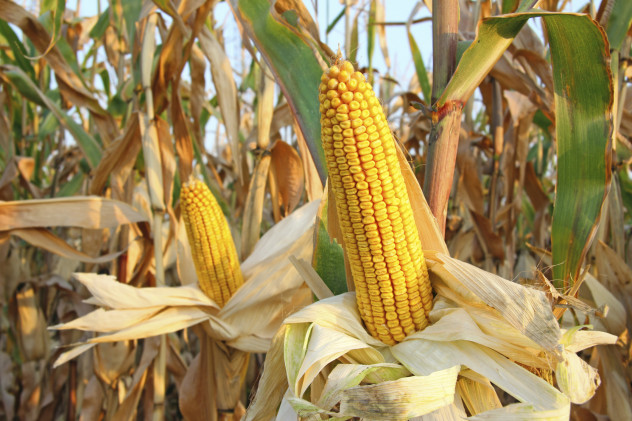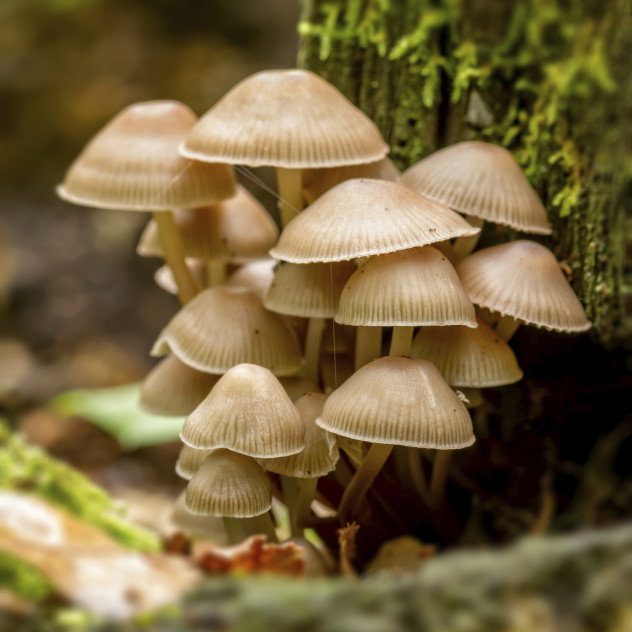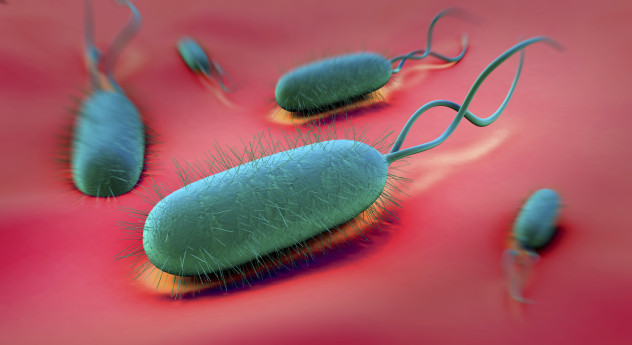But botany is actually at the forefront of science. The field helps to inform and shape those more sexy fields that get all the cameras and attention such as genetics, biotechnology, paleontology, and climate change studies. However, there are many botanical observations that are promising to change the world today.
10Fungi Can Increase Crop Yields
In 2014, scientists learned how to use the symbiotic relationships that plants forge with fungi in order to increase crop yields while also using less fertilizer. Scientists have long known that most plants use beneficial fungi in the soil around them to produce mycorrhizae (fungal roots). These fungi possess long-reaching filaments—called hyphae—that can reach nutrients that a plant’s own roots cannot. This relationship helps plants collect these nutrients more efficiently. Now, a team of researchers, led by Dr. Michael Schultze of the Department of Biology at York in England, has discovered a protein (known as a “proton pump”) which acts as the interface between the fungi and plant root cells. This allows nutrients to pass on to the plant. This observation was published in the journal The Plant Cell that is produced by the American Society of Plant Biologists. Dr. Schultze has stated that the mycorrhizae-specific proton pump would be a way for plant breeders to increase crop yields, while minimizing use of fertilizers, by taking advantage of the natural increase in nutrient gains. Mineral fertilizers are a notorious source of environmental problems. They can lead to soil erosion and contamination of groundwater with nitrates and phosphates. High levels of nitrates are dangerous to human health. Phosphate contamination leads to algae overgrowth as algae die and leech oxygen out of the water as it decomposes—a process called eutrophication.
9Important Benefits Of Corn—Beyond Pest Resistance
Bt corn (treated with the bacteria Bacillus thuringiensis) is the well-known genetically modified corn variety that is bred to be resistant to corn rootworms. These Midwestern US pests devastate crops in both the larval and adult beetle form. Corn rootworms costs growers upward of $1 billion per year. Bt corn protects itself by producing a pesticide called BT (which is a bacterial toxin) within itself. This reduces the need for the corn to be sprayed with pesticides. Besides the obvious benefits, scientists have found that Bt corn often exceeds expectations and produces larger yields than expected. In 2012, Fred Below and Jason Haegele of the University of Illinois at Urbana-Champaign published a study that determined that Bt corn boosts yields by increasing nitrogen intake while simultaneously increasing nitrogen use efficiency. By not having to invest in costly strategies to protect against pests, the plants find themselves free to develop more healthy and active root systems which leads to increased production all around. Bt corn also promises to benefit scientists who research root systems. Large populations of plants growing close together—like crop plants—can produce large networks of root systems if those roots are protected from pests. This gives researchers a greater reservoir of resources to work with when trying to understand how root systems work. This, in turn, can lead to new fruitful avenues of research and development.
8Robots Inspired By Plants
Researchers from an EU-funded project at the Istituto Italiano di Tecnologia are working on a series of advanced robotic projects inspired by what seems to be an unlikely source: plant life. Barbara Mazzolai is the coordinator of the FP7-PLANTOID project, which aims to design and prototype hardware and software solutions in the field of robotics inspired by plants. This includes the way they move, sense the world, and even the way their roots grow. While many see plants as passive organisms that do virtually nothing, plants do, in fact, move. Many times this movement is in “extremely efficient ways.” The group has developed a general prototype that aims to make use of the ways that plants interact with the world. It features a 3-D printed trunk and leaves that sense things such as temperature, gravity, and humidity. It also has a root system that grows and changes direction as needed. This is the first time that scientists have looked to plants to solve robotics-based problems. Mazzolai and her team eventually hope to use this work in fields as diverse as agriculture, medicine, and space exploration. They envision future robots that could be dropped on an alien world where they would implant themselves and use sensory information to adapt to harsh environments. Another possibility is to create flexible endoscopic surgical robots that could travel through the human body. The PLANTOID project is backed by €1.6 million in funding from the EU and is projected to be finished in 2015. The team is currently working on a more advanced prototype with more abilities. They hope to develop a model that uses its external environment to draw energy and smarter robots that can learn from environmental cues and make decisions based upon them. You can follow the progress of the project and learn more here.
7Desert Farming Techniques
Recent research on desert farming techniques has led to new observations about how plants forge relationships with bacteria to promote growth. This has important potential applications. In a 2012 study published in PLOS ONE, researchers used a drought-sensitive pepper plant (Capsicum annuum L.) and focused on the organisms that grew around it under drought conditions. They did this by dissecting root systems and sampling both cultivated and uncultivated soils. They found that, when subjected to drought conditions, the bacteria surrounding the plants were enriched, and it drove plants to as much as a 40 percent increase in photosynthesis and biomass production. The more plant biologists are studying the ways that plants interact with the organisms that grow around them, the more it makes sense to talk of plants as a “meta-organism” where the microbiome around it is just as much a part of the whole as the plant itself. In a world where climate change and growing human populations will place great stress on water availability and the amount of land usable for agriculture, this research will help us by retaining high crop yields using minimal irrigation.
6Seaweed Farming
As algal blooms close beaches and disrupt ecosystems, algae has been a growing environmental concern for quite some time. It’s viewed by many as a scourge and a problem we need to eradicate. But one group of researchers does not agree. They said, “In our research, we turn the argument on its head and see algae as a resource. We collect excess algae along the coasts and cultivate new algae out at sea.” Why would they do this? Fredrik Grondahl, head of the Seafarm Project at the KTH Royal Institute of Technology in Sweden, hopes to use algae as a cheap and plentiful source of food, medicine, plastic, and biofuel. Humans use almost 40 percent of the production derived from land-based ecosystems but only about 1 percent of what the sea can produce. The excessive fertilization of our oceans due to human activity—called eutrophication—ends up creating too much algae and, to make things worse, what we do produce from the sea is mostly exploitive. Some fishing practices, including trawling, ravage the oceans. Trawling kills thousands of living things that are never used in order to get the fish that trawlers want. Utilizing the potential of algae could change all of that. Its utility is incredible and almost completely overlooked in most Western cultures. Algae contains vitamins, amino acids, and minerals. It can be eaten plain or used to produce spices and oils. It can also replace more environmentally damaging forms of animal feed. Brown algae can produce three times the amount of sugar found in sugar beets. Grondahl’s Seafarm project grows algae on barrels and then harvests them on land, where they are further processed through biorefining processes. His farm, and other projects like it, have immense potential to change the world. Other nations have been using algae for quite some time. Many parts of Asia, particularly Japan, have been using it for centuries. Ireland, a nation with a long tradition of using seaweed, has developed extensive algae cultivation projects since 2010. In 2011, Norway began similar projects. So, maybe the sea farms envisioned by science fiction writers and futurists are finally on their way.
5New Fungi Observations Could Lead To Improved Fungicides
A new study from researchers at the University of Exeter in England, published in the October 2014 issue of Nature Communications, shows the mechanism in which most pathogenic fungi avoid the immune systems of the plants that they attack. This finding promises to lead to a whole new generation of fungicides. Biosciences Professor Gero Steinberg of UOE has pointed out that pathogenic fungi possess major potential to disrupt world food security and already cost billions of dollars in damage. He said, “In fact, losses of wheat, rice, and maize to fungal pathogens, per year, are the same as the annual spent by (the) US Department of Homeland Security—some $60 billion.” It turns out that most pathogenic fungi inject a plant with effector proteins that allow it to bypass automatic immune system responses and get into plant cells. The fungi use signaling organelles—called early endosomes—that travel between the fungal cell’s nucleus and the point of invasion. They act as messengers and deliver the proteins which then allow the fungus to safely make its way into the plant. By learning how to disable this process, researchers should be able to deliver new fungicides that treat the disease before the fungus ever gets a chance to do its dirty work. Current fungicides are often swiftly rendered ineffective by pathogenic fungi because their fast growth rates help them adapt quickly to anti-fungal treatments.
4Human Gut Microbes May Provide Plant Biofuels
In order to use plants as biofuels, scientists need a way to efficiently break down a plant’s cell walls. Traditionally, they do this by using certain microbes that possess the useful trait of doing just that. Likely candidates include the microbes that exist in cow rumens and termite guts. But in a 2014 study in the Proceedings of the National Academy of Sciences, Professor Isaac Cann of the University of Illinois and his team of researchers believe that they have found a better candidate—in the human gut of all places. The study confirms an earlier hypothesis that gut microbes in humans have the ability to digest fiber and turn it into sugars that, in turn, ferment nutrients that human cells use. These same sugars can be fed to yeast to generate ethanol and other liquid fuels. Two of the microbes found in humans—Bacteroides intestinalis and Bacteroides ovatus—appear to be more efficient at breaking down complex plant fibers than even those found in cows. Besides having important implications for human health, this discovery can greatly benefit the biofuels industry which, in turn, can allow us all to reap huge environmental benefits.
3Trees That Can Increase Bio-Production
Researchers from the Center for Plant Biotechnology and Genomics have developed a new form of biotechnology: A technique for increasing the biomass production of a forest plantation without altering a tree’s growth rate, composition, or anatomy. Not only does this increase the overall production of trees without increasing the trees’ food demand, it does so in ways that can mitigate the effects of global warming and enhance energy security by allowing for far greater wood production in the same amount of space. They did it through a technique that modifies the expression of certain genes that are responsible for a process called “syleptic branching” in trees, which increases the number of branches, size of leaf area, and overall growth. The researchers claim that their technique can potentially work on any woody plant species. Because of its potential applications to the bioenergy sector and energy markets, the process has been patented.
2Sound Vibrations May Soon Boost Harvests
In Europe, many countries have extensive pesticide bans in place. This puts pressure on researchers to find alternative methods of controlling pests. Could it be possible to one day replace many of the world’s pesticides with a sound and odor-based insect control system? Researchers in Italy think so. Ilaria Pertot and a team of EU researchers working on the PURE Project have been experimenting with sound vibrations and pheromones to disrupt the mating behavior of the European grape berry moth and the cicada Scaphoideus titanus—two common grape pests. With grapes alone accounting for 38 percent of pesticide use throughout Europe, it’s easy to see how this research could have immense environmental benefits even if it turns out not to have widespread applicability. The researchers claim that, based on their study so far, the methods they are developing are as efficient, if not more so, than the use of chemical pesticides and may be able to replace them altogether.
1Chinese Plant Diversity Crucial To Global Food Security
The West has had a few reasons to envy China over the last few decades and it may well have another one. A botanical team from the University of Birmingham in England, along with partners from China, claim that the huge amount of plant diversity in China may be crucial to global food security in the future. China’s flora includes over 20,000 higher plant species. The researchers identified 871 of these native species that are known as crop wild relatives (CWR). They are called this because of their genetic potential to adapt and help maintain 28 important global crops (such as rice, wheat, soybeans, and many others). Some are used to help crop plants improve resistance to cold or provide resistance to toxins. Others have improved drought resistance or improved nutritional qualities such as protein content. Forty-two percent of them occur nowhere else in the world. However, it’s not all good news. The researchers also found that at least 17 percent of these enormously valuable species are in danger of extinction and require immediate attention. In the meantime, with a database of all the species completed, efforts are under way to start preserving the species in gene banks in order to retain their valuable traits. The world is only just beginning to realize the importance of CWRs and other wild plants in the fight to mitigate the effects of global warming and ensure agricultural economic stability. Researcher Shelagh Kell said that the politics involved are incredibly complex and that, “urgent attention needs to be paid to China’s CWR to ensure that they are adequately conserved, so that this diversity is available for use in crop improvement programs before it is lost forever.” Lance LeClaire is a freelance artist and writer. He writes on subjects ranging from science and skepticism, atheism, and religious history and issues, to unexplained mysteries and historical oddities, among other subjects. You can look him up on Facebook, or keep an eye out for his articles on Listverse.
























